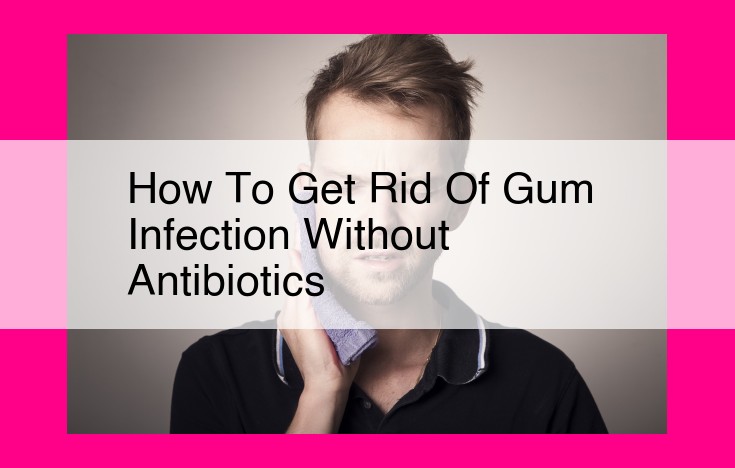Gum Disease Treatment: Eliminate Infection Naturally With Non-Invasive Methods

To combat gum infection without antibiotics, dentists and periodontists recommend non-invasive treatments like scaling and root planing, which removes plaque and calculus, and laser therapy, which eliminates bacteria. Additionally, adopting a meticulous oral hygiene routine involving regular brushing, flossing, and avoiding sugary and acidic substances can significantly reduce the risk of developing or worsening gum disease.
Medical Professionals and Organizations: Guardians of Gum Health
Gum disease, a prevalent oral ailment, demands the expertise of medical professionals and organizations dedicated to safeguarding gum health. At the forefront are dentists, who play a pivotal role in diagnosing and treating gum disease through regular checkups and cleanings. Their expertise extends to identifying early signs of gum inflammation (gingivitis) and recommending appropriate interventions.
Periodontists, specialized dentists, possess advanced training in the treatment of gum disease. They wield specialized techniques like scaling and root planing, essential for removing plaque and tartar below the gum line, effectively combating gum inflammation and preventing its progression.
The American Dental Association (ADA) serves as a guiding force in promoting oral health, including gum disease prevention and treatment. Through educational initiatives and evidence-based guidelines, they equip dentists with the knowledge and tools to provide optimal care for their patients.
Finally, the National Institute of Dental and Craniofacial Research (NIDCR), a division of the National Institutes of Health, spearheads research into the causes, prevention, and treatment of gum disease. Their groundbreaking work advances our understanding of this ailment, leading to innovative therapies and improved outcomes for patients.
Non-Antibiotic Medical Treatments for Gum Disease
Gum disease, a common oral health issue, can lead to various problems if left untreated. Fortunately, there are effective non-antibiotic medical treatments that can help combat this condition.
Scaling and Root Planing
This procedure involves removing tartar and bacteria from the teeth and below the gum line. The dentist uses a special tool called a scaler to gently scrape away these harmful substances, which can cause inflammation and damage. Root planing smoothes out the tooth roots, making it harder for bacteria to attach. This thorough cleaning helps reduce inflammation, heal gum tissue, and prevent further damage.
Laser Therapy
Laser therapy is a minimally invasive treatment option that uses a laser to target and kill bacteria in the infected gum pockets. The laser’s precise energy destroys the bacteria without harming the surrounding tissues. This procedure effectively reduces inflammation, promotes healing, and minimizes the risk of periodontal disease progression.
Effectiveness of these Treatments
Studies have shown that both scaling and root planing and laser therapy are effective in treating gum disease. They can significantly reduce bleeding, swelling, and pocket depth, which are signs of improved gum health. These procedures also help prevent bone loss, which can occur in advanced stages of periodontal disease.
Non-antibiotic medical treatments offer a safe and effective way to combat gum disease. By removing harmful bacteria, reducing inflammation, and promoting healing, these treatments help maintain optimal oral health and prevent further complications. If you have concerns about gum disease, it’s highly recommended to consult with a dental professional to discuss the most appropriate treatment options for your individual needs. Together, you can achieve a healthy smile and enjoy the benefits of long-lasting oral well-being.
Lifestyle Changes for Healthy Gums: Prevention and Management
Maintaining optimal oral hygiene is essential for preventing and managing gum disease. This involves brushing your teeth regularly twice a day with a fluoride toothpaste and flossing daily. It’s important to use a soft-bristled toothbrush and brush gently in circular motions to remove plaque and bacteria from the surfaces of your teeth and gums. Flossing helps to remove food particles and bacteria from between your teeth, where your toothbrush can’t reach.
Your diet can also have a significant impact on your gum health. Limiting your intake of sugary and acidic foods and drinks can help to prevent the growth of bacteria that can cause gum disease. Instead, opt for healthy snacks such as fruits, vegetables, and nuts. Drinking plenty of water throughout the day helps to keep your mouth moist and can also help to flush away bacteria.
Smoking is a major risk factor for gum disease, so quitting smoking is one of the best things you can do for your oral health. Smoking damages the tissues in your gums and makes them more susceptible to infection. If you’re a smoker, talk to your doctor or dentist about resources to help you quit.
By making these lifestyle changes, you can help to prevent and manage gum disease, and improve your overall oral health.
Other Related Entities in the Context of Gum Disease
When discussing gum disease, it’s important to understand the interconnectedness of several key concepts:
Gum Disease
- Gingivitis: Early stage of gum disease characterized by inflammation and bleeding gums.
- Periodontitis: Advanced stage of gum disease that affects deeper tissues and bone.
Bacteria
- Streptococcus mutans: A common bacteria that causes tooth decay and can contribute to gum disease.
- Porphyromonas gingivalis: A specific bacterium that has been linked to severe gum disease and bone loss.
Infection and Inflammation
Gum disease is caused by bacterial infection that triggers inflammation in the gums. This inflammation can damage the gums and supporting tissues. As the infection and inflammation progress, they can lead to periodontitis and bone loss.
Oral Health and Dental Hygiene
Maintaining good _oral health_ and practicing proper _dental hygiene_ are crucial for preventing and managing gum disease. This includes regular brushing and flossing to remove plaque and food particles that can harbor bacteria. Avoiding sugary and acidic foods and drinks also helps reduce the risk of developing gum disease.